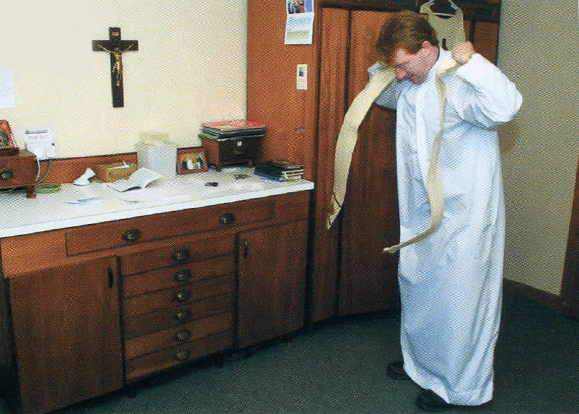On the surface everything at two County Clare villages in the west of Ireland appears as it’s always been. Church bells tolling across Lough Graney call the faithful to Sunday services at Kilanena and Flagmount. The two churches make up one parish either side of the lake, but these days the parish is getting by without a priest of its own.
℘℘℘
By the time Fr. Michael Collins blows into Kilanena parishioners will be fully prepared for 10 o’clock mass at St. Marys. Altar boys and girls will be ready, hymn sheets distributed, readers and collectors in position. After the final blessing Fr. Collins will get back in his car and drive around the lake to Flagmount where the same preparations are set for 11 o’clock.
When his work finishes he will return home, not to Kilanena or Flagmount but to his lodgings at Bodyke village 10 miles away.
It’s strange to think of a mission-type system in a country that has sent missionaries around the world, but this Killaloe diocese is leading the way.
In pre-famine times the Kilanena-Flagmount parish numbered a community of over 5,000. Now it’s under 700. And the two churches on either side of the lake are getting by without a priest of their own.
Under this trial structure Fr. Collins says Sunday mass and performs most community services. In the event of an emergency, the parish priest at Feakle, five miles away, can be called upon.
“It’s a massive shift,” agrees Fr. Collins. “There are things the priest would normally be involved in and you have to say, ‘Can’t do it.’ You are trying to get the community into a new way of looking at parish life, to make them look outside the immediate parish. That’s a big change. It’s breaking the connection between a priest and a parish.”
For the moment the Kilanena-Flagmount parish is the only one in Ireland without a full-time priest. Further cutbacks are inevitable, however. Some churches will close, parishes will share priests and the number of masses will be reduced.
Fr. Collins’ arrival highlights the Church’s wider difficulties. At 27, he is the only priest of his generation in the whole diocese. Vocations have dwindled to double, if not single, figures. Over 60 percent of priests in Ireland are aged over 50. The youngest parish priest in East Clare is 58 years old. What’s more, there are as many priests aged over 80 as there are aged under 29.
Indeed, the gradual disappearance of clergy from traditional decision-making roles — such as in schools or at the local GAA club (Gaelic Athletic Association which promotes hurling and Gaelic football) — marks a major social change.
“The reality is there will have to be a serious planning program in place for every diocese now,” says sociologist Fr. Boland, “on the basis of: What is the Church for? How does the Church respond to the spiritual needs of people in the future? We have to see the Church purely as a vehicle for bringing Christ’s message to the people and not so much as an end in itself. How it does that in a post-modern Ireland has to be worked out.”
What comes to mind is the image of priests as flying doctors, always on call but only for occasions they are really needed. “The difference is the flying doctor goes in, bandages the wound and may not need to come back. I can’t just fly into Kilanena of a Sunday and go away again. I’m not just going up there to say Mass,” laughs Fr. Collins.
Parochial houses in both villages are used for parish council meetings and other matters. Locals come and go like anchor tenants, the door key in their hands. “I didn’t imagine it would ever come to this but everything has changed,” says Anne Collins, who organizes readers for each Mass.
“I don’t think we could have done anything better than we did,” adds Mary Noone, another member of the parish council. “Even though there was a lot of anger and frustration, we got down to business quick enough.”
Fr. Bohan regards it as change in the right direction. “It should have happened years ago,” he says, suggesting that the concept of the priestless parish is imminent, even if to date it’s been fumbled through for the wrong reasons. “The key findings from research at the Céifin Institute is that the two systems that hold a society together — family and community — are breaking down. We can’t look at the Church in isolation, and centrally planned institutions don’t function as easily any more in Irish society. The Church needs to develop a program to address the huge inadequacy of its structures.
“What we have at Kilanena is a new model of Church. It should not come about because there’s a shortage of priests but because it’s the way of the future. People want to participate.”
The drive towards spiritual self-sufficiency has brought subtle but dramatic consequences. The more conservative figures in Kilanena-Flagmount didn’t want independence; now they’re getting to like it.
“People have gotten used to working it out for themselves,” agrees Mary McMahon. “The change it has brought is that we have to do everything for ourselves, whether we like it or not.We got dumped in at the deep end. There isn’t an awful lot different except there is Mass only one day a week in the parish. Everything else goes on as before.”
“I wouldn’t go back,” insists council member Rena Glynn. “I’d hate to think the priest would take over all the duties again. It’s a new role to us and there’s great satisfaction making it work.” ♦


Leave a Reply